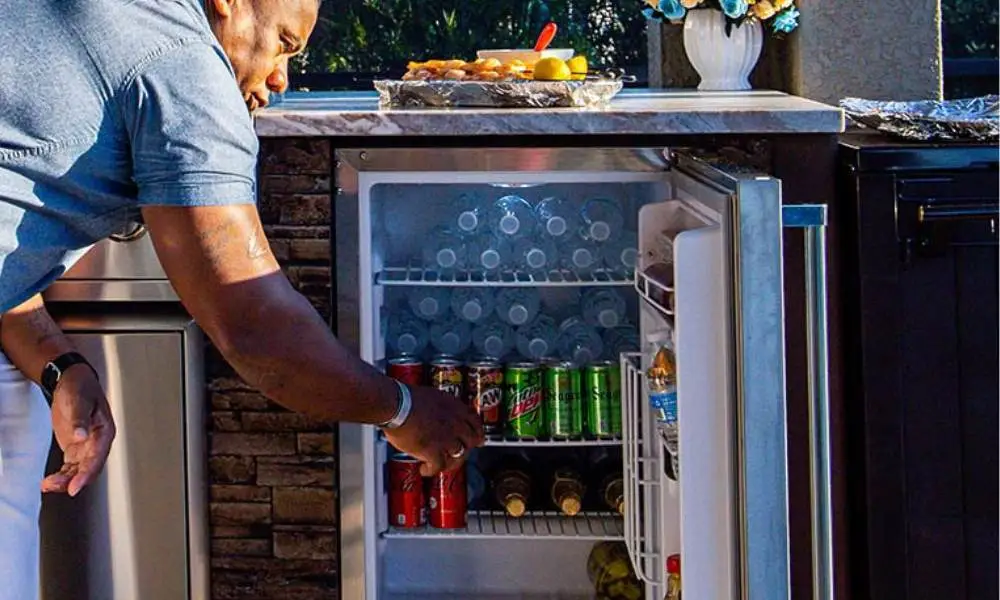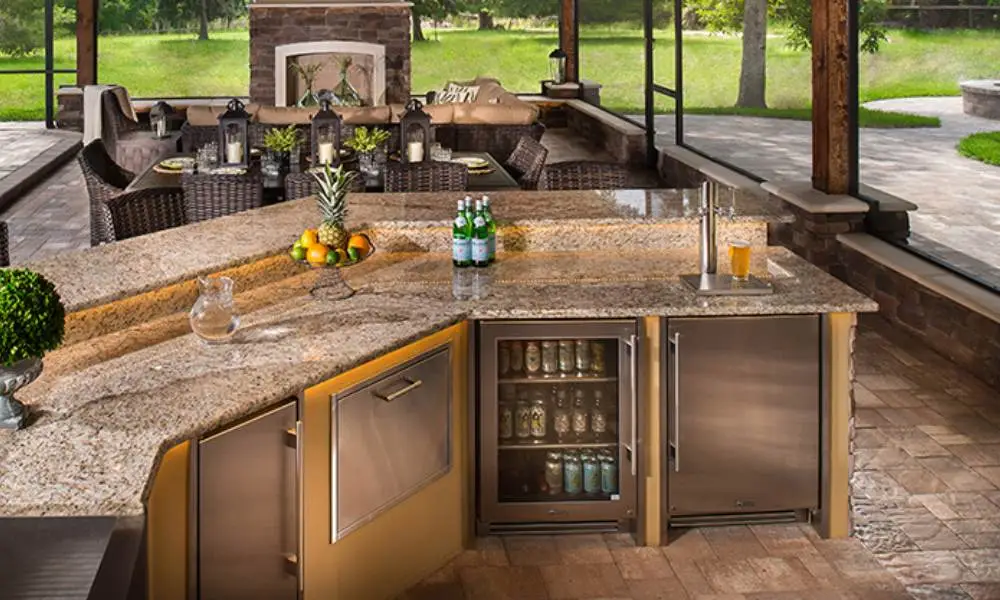Having an outdoor refrigerator can be a convenient way to keep drinks cold and food fresh while spending time in your backyard or patio. But is it safe to put your refrigerator outside?
In this comprehensive guide, we’ll cover everything you need to know about outdoor refrigerators, including:
- The differences between indoor and outdoor fridges
- Factors to consider before putting a fridge outside
- Tips for protecting your appliance outdoors
- Benefits of an outdoor refrigerator
- FAQs on outdoor fridge usage and safety

The Differences Between an Indoor Fridge and an Outdoor Fridge
While refrigerators all work to keep food cold using a compressor and refrigerant, there are some key differences between fridges designed for indoor vs. outdoor use:
Temperature Range
Outdoor refrigerators are engineered to maintain proper temperatures across a much wider ambient temperature range than indoor models.
- Indoor fridges are designed to operate optimally between 55°F and 80°F.
- Outdoor fridges can continue cooling even when ambient temps range from -20°F to 110°F.
This gives outdoor units an advantage in maintaining interior temps despite hot or cold exterior conditions.
Construction
Outdoor refrigerators have enhanced insulation and weatherproofing:
- Thick insulation regulates interior temps and reduces strain on the compressor.
- Weather-resistant exterior prevents rust and corrosion.
- Tight door seals retain cold air and prevent intrusion of moisture and insects.
- Condensation control prevents water damage to exterior.
They are built sturdy to withstand full exposure to the elements year-round.
Materials
Outdoor fridges are constructed from materials made to resist corrosion and rust, such as:
- 304 stainless steel: More rust-resistant than lower grades of stainless steel.
- Marine-grade aluminum: Specially treated aluminum alloy resists corrosion from salt air.
- ABS plastic: Impact-resistant exterior won’t dent, rust or peel.
Cost
Outdoor refrigerators have a higher upfront cost and operating expense than comparable indoor models due to their advanced engineering. Expect to invest more for the added durability and performance.
Here are detailed tables summarize the key points on using a refrigerator outdoors:
| Feature | Indoor Fridge | Outdoor Fridge |
|---|---|---|
| Operating Temperature Range | 55°F to 80°F | -20°F to 110°F |
| Insulation | Standard insulation | Enhanced thick insulation |
| Exterior | Metal or plastic prone to dents, rust | Rust-resistant stainless steel or aluminum |
| Door Seals | Standard PVC or rubber gasket | Heavy duty multi-lip seals, tighter tolerance |
| Cost | Lower starting price | More expensive due to materials and construction |
| Compressor | Standard cooler or freezer compressor | Heavy-duty compressor with larger capacity |
| Weather Rating | Not weatherproof | Weatherproof construction for all-season outdoor use |
But for permanent outdoor installation, an appliance designed for the elements is best.
Also Read: Can I Leave a Chest Freezer Outside?
Can You Store a Regular Fridge Outside?
Indoor refrigerators lack the special construction to withstand outdoor conditions safely long-term. Their interior temperature regulation fails below 55°F or above 80°F.
You can use an indoor fridge outside temporarily, like during a party, with proper precautions:
Choose the Right Location
- Keep the unit shaded and out of direct sun/rain. Overhangs, balconies, or covered patios are ideal spots.
- Allow at least 4 inches clearance on all sides for airflow. Avoid placing it in corners or tightly enclosed spaces.
- Set the fridge on a level surface raised off the ground, like a deck or concrete pad.
- Make sure the electrical outlet is GFCI protected and the power cord reaches.
Avoid placing it in direct sun or up against the house which can warm the exterior.
Also Read: How to Move a Refrigerator Without Breaking Your Back
Buy a Purpose-Built Outdoor Unit
Look for refrigerators designed just for outdoor use, labeled for “outdoor”, “patio” or “wet conditions”. Not only are they safer, they will hold up better long-term.
Outdoor Maintenance
- Keep the fridge exterior clean. Wipe up spills promptly before they become sticky.
- Check door seals regularly and replace if cracked or torn.
- Clean condenser coils every 3-6 months for maximum efficiency.
- Keep air vents clear of leaves, dust and cobwebs.
Monitor Ambient Temperature
On very hot or cold days, check that the fridge is maintaining proper internal temperatures. You may need to adjust the thermostat.
Use Surge Protection
Use a dedicated outdoor surge protector to avoid damage to the electrical system from lightning strikes or power surges.
Following these best practices will keep your outdoor refrigerator running safely and allow you to enjoy chilled drinks and fresh foods outside!
Benefits of Having an Outdoor Refrigerator
Here is a table outlining the benefits of having an outdoor refrigerator:
| Benefit | Description |
|---|---|
| Endless Cold Drinks and Snacks | Keep beverages, fruits, dips, desserts chilled outside anytime. |
| Better Party Hosting | Guests can self-serve so you can enjoy the party. |
| Free Up Indoor Fridge Space | Store bulk items outside to open up kitchen fridge room. |
| Keep Food Fresh During Meals | Condiments, salads stay fresher with fridge handy outdoors. |
| Outdoor Entertaining Autonomy | Everything you need is outdoors for flexibility. |
| Store More Frozen Treats | Dedicated freezer units let you stock up on popsicles, ice cream, etc. |
| Enjoy Cold Drinks Anytime | Grab a chilled soda, beer, wine whenever you want outside. |
Also Read: How to Reset a Whirlpool Refrigerator (Fix Not Cold/Cooling)
Using an Outdoor Fridge in Cold Weather

Can you operate an outdoor refrigerator in freezing winter temps? Here’s what you need to know:
How Low Temps Affect Fridges
Once the outdoor temperature drops far below the fridge’s interior temp, two problems can occur:
- The fridge may not cycle on properly. The thermostat gets confused and fails to activate the compressor to cool things down.
- The compressor oil can thicken. This prevents proper circulation and lubrication of components. Prolonged operation in very cold conditions can lead to compressor failure.
Tips for Winter Usage
Here are a few options for keeping your outdoor fridge running during winter:
- Move the refrigerator to an insulated garage or enclosed porch for the winter months.
- Place a weatherproof insulating cover over the fridge.
- Install a thermostatically controlled outlet to only allow operation above freezing temps.
- Drain and winterize the fridge if it will sit idle below freezing for weeks.
Avoid operating the fridge if ambient air temps remain below 30° F for long periods. The strain and risk aren’t worth potential food loss or appliance damage.
Also Read: How to Easily Force Defrost Your Samsung Refrigerator
Using an Outdoor Fridge in Summer
The hot temperatures of summer make having an outdoor refrigerator incredibly useful. Here are some tips on using your outdoor fridge when the weather is warm:
Adjust Cooling Setting
Monitor interior temps closely in summer. You may need to:
- Turn the refrigerator down to the max cold setting.
- Move items like produce to crisper drawers.
- Allow extra time for drinks and new containers to chill down.
- Switch to a thermally insulated cooler if fridge struggles to keep up.
Utilize Maximum Space
Take advantage of every inch of storage space when stocking up:
- Fill door bins and shelves fully but allow some air circulation.
- Rotate new items to the back; use oldest items first.
- Avoid overpacking which limits cold air flow.
How Much Electricity Does an Outdoor Fridge Use?
When considering an outdoor refrigerator, energy efficiency is an important factor along with upfront cost. Here is a look at the estimated electricity usage for different sizes of outdoor fridges:
Mini Outdoor Refrigerators
Small outdoor mini fridges in the 1.7 to 4.4 cubic foot range use approximately:
- 233 – 310 kWh per year (according to Energy Star estimates)
For example, an energy efficient 4.4 cu ft mini fridge uses around $27 worth of electricity annually (based on Consumer Reports testing).
Mid-Size Outdoor Refrigerators
For medium-sized outdoor refrigerators between 4.5 and 9 cubic feet, expect approximately:
- 350 – 520 kWh per year
This is similar to electricity use for a mid-size indoor kitchen refrigerator.
Full-Size Outdoor Refrigerators
For larger full-sized outdoor refrigerators (16 cubic feet and above):
- 550 – 850 kWh per year
These larger units use similar energy to their indoor kitchen counterparts.
The main driver of electricity usage for any refrigerator is the interior cubic footage – bigger units require more energy to run. Other factors like the efficiency of the compressor, insulation, and condenser coils also play a role.
Installing your outdoor fridge in a shaded location, cleaning coils, and allowing proper ventilation can help maximize efficiency and reduce electricity usage. Energy Star also recommends adjusting the temperature setting no lower than necessary.
Why Are Outdoor Refrigerators More Expensive?
When comparing prices, outdoor refrigerators have a higher starting cost than indoor models. What accounts for the price difference?
Stainless Steel Construction
The all-weather stainless housing prevents rust and dents that could happen with cheaper steel or plastic.
Enhanced Weather Seals
Thicker, more durable gaskets and insulation retain the cold air better than on indoor models.
Stronger Compressor
It must cool efficiently despite hot temps, direct sun, and frequent openings. More robust parts = higher cost.
Advanced Cooling Systems
Forced-air cooling, quicker recovery times, and backup systems keep contents colder.
Rugged Features
Sturdy Shelves, reinforced hinges, locking doors, and drains allow them to take more abuse.
Limited Production
Specialized outdoor fridges are lower volume compared to mass-produced indoor units.
While the price is higher compared to indoor refrigerators, outdoor fridges provide unparalleled performance and convenience for patio and backyard entertaining.
Frequently Asked Questions
Can I use an indoor mini fridge outside?
Mini fridges are designed for indoor use only. The compressor and components will wear out quickly or fail if exposed to outdoor temperatures for long.
How long will an outdoor refrigerator last?
On average an outdoor refrigerator will operate reliably for 8-12 years with proper maintenance, compared to 10-15 years for an indoor unit.
What temperature should I set an outdoor refrigerator to?
Between 34°F – 40°F for the refrigerator compartment and 0°F for the freezer is ideal. Adjust as needed based on ambient temps.
Can you put a refrigerator in a garage without insulation?
Lacking insulation, the garage temps will fluctuate with the outdoor air. This will lower efficiency and strain the fridge. Insulating the garage is recommended.
Should I keep my outdoor fridge covered?
A cover is recommended to protect it from rain, frost, blowing leaves, and help maintain stable temps in cold or hot weather.
How long can a refrigerator stay in the heat?
Running a fridge in temps above 90°F will strain the unit. It’s best to move it to shade or cover it to prevent heat damage and food spoilage.
Key Takeaways
- Outdoor refrigerators are specially designed to withstand full weather exposure and maintain proper food storage temps in any conditions.
- Indoor refrigerators can be used outside temporarily but are not as durable long-term.
- Position your outdoor fridge in a protected area and maintain it properly.
- Outdoor fridges allow you to conveniently store cold drinks, appetizers, and more during patio parties and backyard fun.
- Use caution operating the fridge below 30°F ambient air temperatures in winter.
- The weatherproof, rustproof construction results in a higher purchase price but provides performance and longevity.
Investing in an outdoor-rated refrigerator lets you get the most from your patio, pool deck, or backyard without having to run back inside. With some preventative care and smart placement, an outdoor fridge will provide years of trouble-free use.